2021 Annual Report for: Crambidae / Spilomelinae
For species seen in 2021 that had less than or equal to 100 records, full details are included; for more common species, the earliest, latest and highest count by vice-county are shown. The narrative for each species is taken from the main Hantsmoths website, and it is possible that some information on abundance and occurrence can get out of date, as it is impossible to keep up with all changes; however it should give a good introduction to each species. The tables in each species account summarise the previous status, and that for the current year.
For the maps, all records prior to 2021 are shown by a blue dot (the larger the dot, the more recent), with the current year's records shown in red. As previous records are superimposed on any report for 2021, new sites have greater emphasis (i.e. will show as 'more red').
In the species accounts, an asterisk next to a location indicates a new 10km square record; earliest ever dates are highlighted in orange, and latest ever in red. Initials in the species accounts refer to the recorders listed here. Please get in touch if you identify any omissions or errors, in particular if you have records that have yet to be submitted. Details of how to submit records can be found here.
63.031 [B&F: 1395] Rusty-dot Pearl Udea ferrugalis (Hübner, 1796) - Migrant
Common immigrant to the British Isles from mainland Europe, most frequent on waste ground by the coast where sometimes abundant. In Hampshire and on the Isle of Wight a common immigrant, which is widely distributed throughout in some years. Wingspan 18-22 mm. The rusty forewing with prominent black discal spot is characteristic of this species [Goater]. Larva feeds on herbaceous plants.
Records prior to 2021
| Vice County | #Records | #Individuals | First Record | Last Record |
|---|---|---|---|---|
| 10 | 1124 | 5080 | 1951 | 2020 |
| 11 | 4874 | 7770 | 1951 | 2020 |
| 12 | 627 | 1038 | 1951 | 2020 |
2021 records
| Vice County | #Records | #Individuals | Max Quantity |
|---|---|---|---|
| 10 | 205 | 697 | 26 |
| 11 | 298 | 431 | 8 |
| 12 | 64 | 79 | 4 |
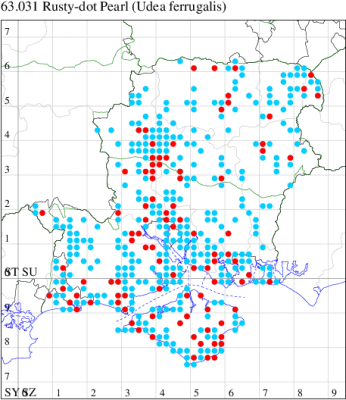
Records by year
Records by week (adult)
Records by week (larval)
Record Summary
VC10: Earliest: Bonchurch, 10 May, 1 (JHa) Latest: Bonchurch, 31 Dec, 3 (JHa) Max count: Freshwater, 06 Oct, 26 (DCoo)
VC11: Earliest: Hurn, 11 May, 1 (MJef) Latest: Marchwood, 20 Nov, 1 (TDCh) Max count: Milford on Sea, 07 Oct, 8 (MMcM)
VC12: Earliest: Alton, 18 May, 1 (BCA) Latest: Kempshott, 18 Nov, 1 (GAH) Max count: Goodworth Clatford, 09 Aug, 4 (JMor)
63.032 [B&F: 1389] Udea fulvalis (Hübner, [1809]) - Migrant
Formerly considered a migrant to southern England from mainland Europe, in some years arriving in sufficient numbers to breed, it now has become established since the mid 1990s predominantly along the south coast of Hampshire inland into the New Forest, and along the north shore of the Isle of Wight; it is spreading northwards and has now reached the VC11/VC12 boundary, and one in the north-east in 2022 represents the first incursion from the Sussex heaths to the east. Wingspan 24-29 mm. Similar in structure, size and markings to U. prunalis, but differs in the dull fulvous brown coloration of the forewing, which is slaty grey in U. prunalis, and in the wider submedian sinus of second line [Goater]. Larva feeds on Black Horehound, Meadow Clary, Red Campion and White Campion.
Records prior to 2021
| Vice County | #Records | #Individuals | First Record | Last Record |
|---|---|---|---|---|
| 10 | 165 | 443 | 1955 | 2019 |
| 11 | 515 | 713 | 1981 | 2020 |
| 12 | 3 | 5 | 2020 | 2020 |
2021 records
| Vice County | #Records | #Individuals | Max Quantity |
|---|---|---|---|
| 10 | 17 | 23 | 3 |
| 11 | 38 | 41 | 2 |
| 12 | 2 | 2 | 1 |
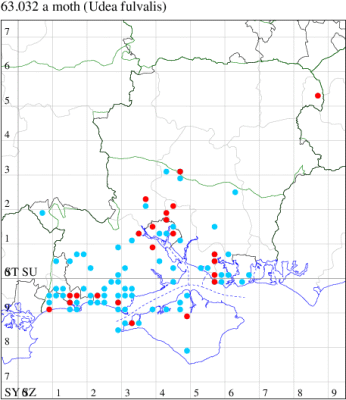
Records by year
Records by week (adult)
Records by week (larval)
Record Details
VC10: Totland, two, 21 Jul; one, 22 Jul; two, 25 Jul; one, 26 Jul; one, 29 Jul; one, 01 Sep (RTer); Freshwater, one, field observation, 07 Jul; one, 13 Jul; one, 16 Jul; one, 18 Jul; two, 22 Jul; one, 04 Aug; two, 11 Aug; one, 14 Aug; one, 23 Aug; one, 31 Aug (DCoo); Newport, three, 29 Jul (DPl);
VC11: Marchwood, one, 07 Aug; one, 13 Aug (CTha); Totton, one, 16 Jul; one, 25 Jul; one, 28 Jul; one, 04 Aug; one, 16 Aug (LHan); Millbrook, one, 22 Jul (JWal); Woodley, one, 27 Jul; one, 30 Jul (NBin); Chandlers Ford, one, field observation, 03 Aug (AMur det. MJW); Swaythling, Southampton, one, 22 Aug (MEdg); Bitterne, Southampton, one, 24 Jul (PAB); Allbrook, one, field observation, 12 Jul (SIng); Lee-on-Solent, one, 14 Aug; one, 17 Aug; one, 20 Aug; one, 25 Aug (IHrg); Fareham, one, 16 Jul; one, 14 Aug; one, 28 Aug (ADT); one, 11 Aug (IMcP); two, to light, 25 Jul; two, to light, 29 Jul; one, to light, 31 Jul; one, to light, 04 Aug (KJW); one, indoors, 24 Jul (RJD); Bournemouth Centre, one, indoors, 23 Aug; Jumpers Common, Christchurch, one, field observation, 30 Jun (MJef); Tuckton, Christchurch, one, 17 Jul; one, 04 Aug; one, 11 Aug; one, 29 Aug; one, 08 Sep (APar); Burton, nr Christchurch, two, 17 Aug (JStw); New Milton, one, indoors, 30 Jul (RPH); Milford on Sea, one, 20 Aug (MMcM); Browndown Coastal Ranges, one, gen det, 20 Aug (RJD, MLO, DWal, KJW);
VC12: Teg Down, Winchester, one, field observation, 29 Jul (CKni); Farnborough, one, 26 Jul (KBW)
63.033 [B&F: 1388] Udea lutealis (Hübner, [1809]) - Common
Common on waste ground, gardens and woodland edges throughout the British Isles. In Hampshire and on the Isle of Wight locally common to abundant, but scarce or absent in many places where, due to its polyphagous nature, it might be expected. Wingspan 23-26 mm. An easily recognised species on account of the pale coloration and dark clouding in apex of hindwing [Goater]. Larva polyphagous on various herbaceous plants, including Bramble, Thistle, Wormwood and Scabious.
Records prior to 2021
| Vice County | #Records | #Individuals | First Record | Last Record |
|---|---|---|---|---|
| 10 | 24 | 18 | 1909 | 2020 |
| 11 | 268 | 311 | 1951 | 2020 |
| 12 | 133 | 116 | 1951 | 2020 |
2021 records
| Vice County | #Records | #Individuals | Max Quantity |
|---|---|---|---|
| 11 | 31 | 45 | 3 |
| 12 | 2 | 2 | 1 |
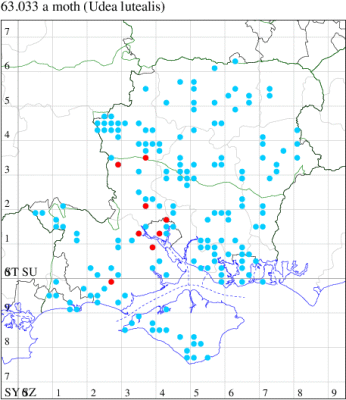
Records by year
Records by week (adult)
Records by week (larval)
Record Details
VC11: Broughton, one, field observation, 19 Aug (GSD); Marchwood, one, 27 Aug (CTha); Totton, one, 13 Jul; three, 14 Jul; three, 16 Jul; one, 17 Jul; one, 19 Jul; two, 21 Jul; two, 22 Jul; two, field observation, 25 Jul; one, 25 Jul; one, 28 Jul; one, 02 Aug; one, 03 Aug; two, 04 Aug; two, 09 Aug; one, 10 Aug; two, 11 Aug; one, 19 Aug; two, 20 Aug; two, 21 Aug; one, 22 Aug; one, 24 Aug; two, 26 Aug (LHan); Romsey, two, 13 Jul (MBak); Freemantle, Southampton, one, field observation, 20 Jul; one, field observation, 29 Jul (CDC); Swaythling, Southampton, one, 11 Jun; one, 19 Aug; one, 27 Aug (MEdg); Sway, one, 26 Jun (DMui);
VC12: Stockbridge Down NT, one, field observation, 27 Jul (MDuf det. PEH); one, field observation, 29 Jul (DKel det. PEH)
63.034 [B&F: 1390] Udea prunalis ([Denis & Schiffermüller], 1775) - Common
Common in thickets, copses and hedgerows throughout the British Isles. Frequently recorded and well distributed across much of Hampshire and the Isle of Wight. Wingspan 23-26 mm. Slate-coloured overall appearance and weak markings distinguish from other Udea species, lack of white patch between the stigmata distinguish from U. olivalis. Larva feeds on various herbaceous and woody plants
Records prior to 2021
| Vice County | #Records | #Individuals | First Record | Last Record |
|---|---|---|---|---|
| 10 | 144 | 167 | 1856 | 2020 |
| 11 | 1787 | 2142 | 1945 | 2020 |
| 12 | 760 | 1052 | 1951 | 2020 |
2021 records
| Vice County | #Records | #Individuals | Max Quantity |
|---|---|---|---|
| 10 | 12 | 13 | 2 |
| 11 | 45 | 56 | 3 |
| 12 | 22 | 33 | 3 |
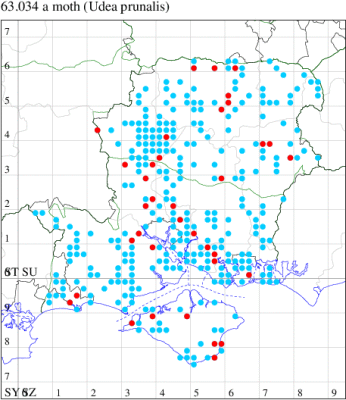
Records by year
Records by week (adult)
Records by week (larval)
Record Details
VC10: Freshwater, one, 30 Jun; one, 02 Jul; one, 16 Jul (DCoo); Cranmore, one, 19 Jul (CHic); Newport, one, 15 Jul; one, 19 Jul (DPl); Wheelers Bay, one, 19 Jul (ABut); Bonchurch, one, 13 Jul (JHa); Shanklin, one, 22 Jul; one, 04 Aug; Shanklin Upper Chine, two, 18 Jul; one, 21 Jul (IOut);
VC11: Marchwood, one, 22 Jul; one, 11 Aug (CTha); Woodlands, NF, present, 09 Jul (RBW); Totton, one, 19 Jul; one, 20 Jul; one, 30 Jul (LHan); Romsey, two, 09 Jul (MBak); Ashley, one, 24 Jul (GCE); Romsey, one, 03 Jul; one, 23 Jul (NRJ); Broughton, one, 25 Jul; Winter Down Copse, Little Somborne, one, 11 Aug; one, 30 Jun; one, 19 Jul (GCE); Itchen Valley CP, three, 16 Jul (CTha); Allbrook, one, 17 Jul (SIng); Botley Wood, one, 13 Aug (MLO, ADT, DWal, KJW); Fareham, three, 30 Jun; two, 16 Jul; three, 17 Jul; three, 18 Jul; one, 20 Jul; one, 21 Jul; one, 11 Aug (ADT); one, 01 Jul; one, 14 Jul (IMcP); one, 08 Jul; one, 18 Jul (MLO); one, 28 Jun; one, 11 Jul (KJW); Botley, one, 09 Jul; one, 24 Jul; one, 07 Jul; one, 17 Jul; one, 22 Jul; one, 28 Jul (SLB); Portsmouth, one, 16 Jul; three, 19 Jul; one, 20 Jul; one, 21 Jul (IRT); Tuckton, Christchurch, one, 08 Jul; one, 13 Jul (APar); Christchurch, one, 11 Aug (PHug); Burton, nr Christchurch, one, 09 Jul; one, 16 Jul (JStw);
VC12: Cholderton, two, 02 Jul (TJN, LFom, HEdm); Little Somborne, three, 12 Jul; Barton Stacey, one, 16 Jul (GCE); Hinton Ampner, one, 21 Jul (ASD); Kempshott, two, 07 Jul; one, 10 Jul (GAH); Ecchinswell, one, field observation, 07 Jul; one, 17 Jul (MJN); Great Haughurst Copse, Axmansford, one, 08 Jul (ACB, GJD); Basingstoke, one, 08 Jul; one, 14 Jul; three, 19 Jul; three, 22 Jul (MJW); one, 18 Jul (RHil); Pamber Forest, three, 16 Jul (GJD); Alton, one, to artificial light, 01 Jul; one, 01 Aug; two, 11 Aug (DBO); one, 18 Jul (NDP); Whitehill, one, 13 Jul; one, 19 Jul (ASto)
63.037 [B&F: 1392] Udea olivalis ([Denis & Schiffermüller], 1775) - Common
Common in woodland, gardens and waste ground throughout the British Isles. Widespread and common in Hampshire and on the Isle of Wight. Wingspan 24-28 mm. Fairly unmistakable. Larva feeds on many different herbaceous plants, including Stinging Nettle, Common Sorrel and Hop.
Records prior to 2021
| Vice County | #Records | #Individuals | First Record | Last Record |
|---|---|---|---|---|
| 10 | 364 | 709 | 1856 | 2020 |
| 11 | 1532 | 2425 | 1951 | 2020 |
| 12 | 1407 | 2510 | 1951 | 2020 |
2021 records
| Vice County | #Records | #Individuals | Max Quantity |
|---|---|---|---|
| 10 | 28 | 57 | 8 |
| 11 | 36 | 68 | 10 |
| 12 | 39 | 58 | 7 |
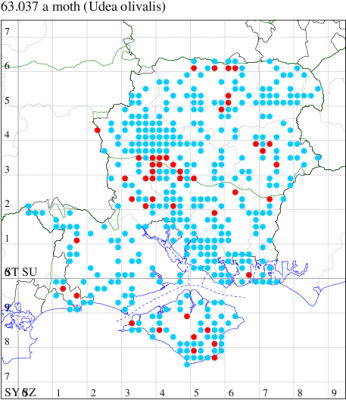
Records by year
Records by week (adult)
Records by week (larval)
Record Summary
VC10: Earliest: Bonchurch, 07 Jun, 1 (JHa) Latest: Shanklin, 18 Jul, 2 (IOut) Max count: Shanklin, 29 Jun, 8 (IOut)
VC11: Earliest: Winchester, 11 Jun, 2 (THW) Latest: Wickham, 30 Jul, 2 (JRDS) Max count: West Meon, 02 Jul, 10 (RJD, MLO, ADT, DWal, KJW)
VC12: Earliest: Ecchinswell, 02 Jun, 1 (MJN) Latest: Axmansford, 17 Jul, 1 (ACB) Max count: Cholderton, 02 Jul, 7 (TJN, LFom, HEdm)
63.038 [B&F: 1405] Mother of Pearl Patania ruralis (Scopoli, 1763) - Common
Common in rural gardens, waste ground and rough pastures throughout the British Isles. Widespread and common in Hampshire and on the Isle of Wight. Wingspan 33-37 mm. One of the largest and most familiar pyralids, wings have an opalescent sheen, most obvious in sunshine, which gives rise to the vernacular name. Larva feeds predominately on Stinging Nettle, living within a spun or rolled leaf.
Records prior to 2021
| Vice County | #Records | #Individuals | First Record | Last Record |
|---|---|---|---|---|
| 10 | 939 | 3827 | 1969 | 2020 |
| 11 | 9448 | 22533 | 200 | 2020 |
| 12 | 3431 | 14628 | 1951 | 2020 |
2021 records
| Vice County | #Records | #Individuals | Max Quantity |
|---|---|---|---|
| 10 | 80 | 236 | 20 |
| 11 | 342 | 608 | 14 |
| 12 | 190 | 793 | 175 |
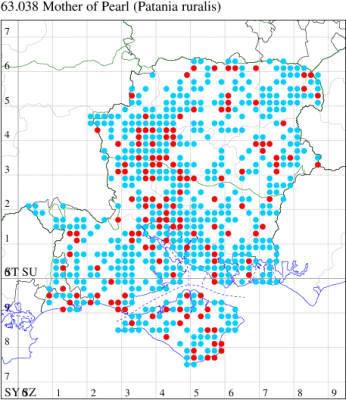
Records by year
Records by week (adult)
Records by week (larval)
Record Summary
VC10: Earliest: Bonchurch, 12 Jul, 1 (PBar) Latest: Shanklin, 16 Sep, 1 (IOut) Max count: Shanklin, 11 Aug, 20 (IOut)
VC11: Earliest: Shirrell Heath, 15 Jun, 1 (LEdg) Latest: Romsey, 24 Sep, 1 (NRJ) Max count: West Tytherley, 04 Aug, 14 (A&LB)
VC12: Earliest: Crawley, 13 Jul, 1 (GCE) Latest: Bullington, 19 Sep, 1 (GCE) Max count: Goodworth Clatford, 11 Aug, 175 (JMor)
63.039 [B&F: 1396] Mecyna flavalis ([Denis & Schiffermüller], 1775) - pRDB2
Rare (proposed as a future Red Data Book species) on chalk downland and grassy slopes in parts of southern England, predominantly coastal. In Hampshire and on the Isle of Wight the species has two strongholds where it is common, on Porton, Broughton and Stockbridge Downs on the mainland, and Compton Down on the Island. Occasional specimens encountered away from these localities suggest that there may be other, perhaps small, colonies still undetected. Wingspan 25-29 mm. Both wings have a very narrow, dark terminal line and greyish cilia, producing a sharply pencilled outline to the wings which, together with the presence of a third stigmatal spot in the forewing, makes this species easy to recognise [Goater]. Larva feeds on Hedge Bedstraw, Field Woundwort, Black Horehound, Small Nettle and Mignonette.
Records prior to 2021
| Vice County | #Records | #Individuals | First Record | Last Record |
|---|---|---|---|---|
| 10 | 61 | 337 | 1856 | 2020 |
| 11 | 85 | 133 | 1951 | 2020 |
| 12 | 41 | 55 | 1981 | 2020 |
2021 records
| Vice County | #Records | #Individuals | Max Quantity |
|---|---|---|---|
| 10 | 4 | 2 | 1 |
| 11 | 5 | 4 | 1 |
| 12 | 5 | 4 | 1 |
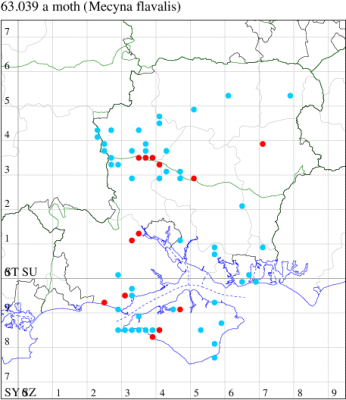
Records by year
Records by week (adult)
Records by week (larval)
Record Details
VC10: Brook, one, field observation, 01 Aug (PTiz); Mottistone Down, present, field observation, 19 Aug; present, field observation, 19 Aug (AEmm); Parkhurst Forest, one, 03 Aug (IOut);
VC11: Woodlands, NF, present, 24 Jul (RBW); Totton, one, 19 Jul (LHan); Kings Somborne, one, 18 Jul (GCE); Taddiford Cliff, one, field observation, 26 Jul (SKee); Pennington, one, 30 Jul (RFC);
VC12: Stockbridge Down, present, field observation, 21 Aug (ABlu); Crawley, one, 04 Aug; one, 04 Aug (GCE); Morn Hill, Winchester, one, field observation, 29 Jul (DAS); Alton, one, field observation, 05 Aug (EFig)
63.040 [B&F: 1397] Mecyna asinalis (Hübner, [1819]) - Nationally Scarce B
Nationally scarce (Nb) on limestone downland and coastal cliffs in Britain, from Sussex to southern Wales, and in southern Ireland. On the Isle of Wight, frequent on the coast. In Hampshire although the foodplant occurs occasionally on the mainland, there are only a very few records of the moth. Wingspan 27-34 mm. Easily recognised by the long, pointed wings and soft blue-grey coloration [Goater]. Larva feeds on Wild Madder.
Records prior to 2021
| Vice County | #Records | #Individuals | First Record | Last Record |
|---|---|---|---|---|
| 10 | 401 | 826 | 1856 | 2020 |
| 11 | 9 | 5 | 1981 | 2009 |
2021 records
| Vice County | #Records | #Individuals | Max Quantity |
|---|---|---|---|
| 10 | 26 | 53 | 9 |
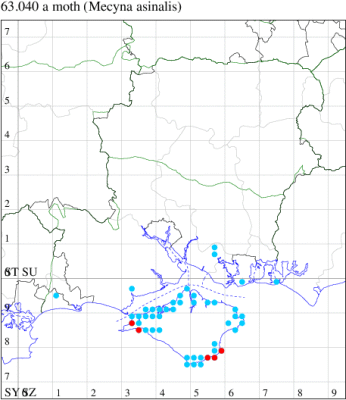
Records by year
Records by week (adult)
Records by week (larval)
Record Details
VC10: Totland, one, 24 Jul; one, 25 Jul (RTer); Freshwater Bay, one, 29 Jun (SDav); Rew Down, Ventnor, one, 13 Jul; one, 11 Jul; two, 15 Jul (PBar); Wheelers Bay, one, 17 Sep; nine, 08 Oct; one, 17 Oct (ABut); Bonchurch, four, 08 Oct (IOut); one, 19 May; one, 29 May; one, 11 Jun; two, 15 Jun; one, 27 Jun; two, 28 Jun; three, 30 Jun; two, 02 Jul; three, 03 Jul; two, 07 Jul; four, 14 Jul; three, 16 Oct (JHa); two, 10 Jul; one, 12 Jul; two, 14 Jul; one, 12 Jul (PBar)
63.041 [B&F: 1410] Agrotera nemoralis (Scopoli, 1763) - pRDB1
Previously considered restricted as a breeding species in the UK to woodland in Kent, with occasional records from elsewhere as presumed migrants; however, in 2014 a breeding colony was found in Torpoint, Cornwall. In our area the only historic record dated from 1946, until another (illustrated here) was taken at MV by John Langmaid in Southsea on 4th June 2010. The first of Isle of Wight record was one to light in Borthwood Copse on 21st June 2015, since when it has been taken annually, indicating probable colonisation of the south-east of the island. Still rare on the mainland, there have been four reports since 2018, which may relate to dispersion across the Solent; remarkably far inland, one turned up in Alton (VC12) in 2023. Wingspan 20-24 mm. Unmistakable. Larva feeds on Hornbeam and Hazel.
Records prior to 2021
| Vice County | #Records | #Individuals | First Record | Last Record |
|---|---|---|---|---|
| 10 | 21 | 24 | 2015 | 2020 |
| 11 | 3 | 3 | 1946 | 2018 |
2021 records
| Vice County | #Records | #Individuals | Max Quantity |
|---|---|---|---|
| 10 | 3 | 4 | 2 |
| 11 | 1 | 1 | 1 |
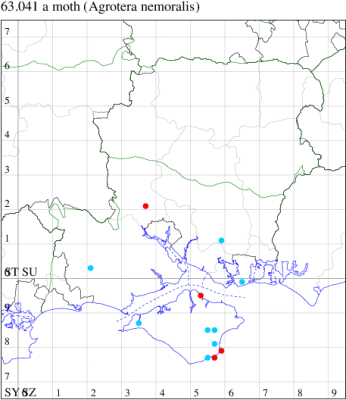
Records by year
Records by week (adult)
Records by week (larval)
Record Details
VC10: Bonchurch, one, 02 Jun (JHa); one, 14 Jul (PBar); Osborne Valley Walk, two, 15 Jun (IOut);
VC11: Romsey, one, 02 Jun (MBak)
63.048 [B&F: 1408] Palpita vitrealis (Rossi, 1794) - Migrant
Immigrant to south-western England from southern Europe. In Hampshire and on the Isle of Wight recorded in most years, chiefly on the Isle of Wight and near the Hampshire coast, occasionally making it as far north as vice-county 12. Wingspan 27-31 mm. Unmistakable. Larva feeds on Summer Jasmine, Olive, Wild Privet and similar, no evidence of breeding in the UK.
Records prior to 2021
| Vice County | #Records | #Individuals | First Record | Last Record |
|---|---|---|---|---|
| 10 | 253 | 499 | 1869 | 2020 |
| 11 | 296 | 306 | 1951 | 2020 |
| 12 | 25 | 22 | 1951 | 2020 |
2021 records
| Vice County | #Records | #Individuals | Max Quantity |
|---|---|---|---|
| 10 | 14 | 19 | 3 |
| 11 | 9 | 10 | 2 |
| 12 | 2 | 2 | 1 |
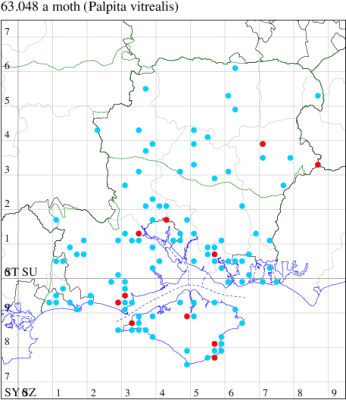
Records by year
Records by week (adult)
Records by week (larval)
Record Details
VC10: Totland, one, 26 Sep (RTer); Freshwater, one, 06 Nov; one, 09 Nov (DCoo); Newport, one, 03 Sep (DPl); Wheelers Bay, one, 07 Sep; one, field observation, 10 Sep; one, 13 Sep; two, 26 Sep (ABut); Bonchurch, one, 01 Sep; two, 08 Sep; one, 16 Sep; three, 08 Nov; two, 10 Nov (JHa); Shanklin, one, 08 Sep (IOut);
VC11: Totton, one, 12 Sep; one, 14 Nov; one, 18 Nov (LHan); Swaythling, Southampton, one, 08 Nov (MEdg); Fareham, one, to light, 13 Sep; one, to light, 07 Oct; one, to light, 08 Oct (KJW); Milford on Sea, one, 22 Oct (MMcM); Pennington, two, 06 Oct (RFC);
VC12: Alton, one, 08 Nov (BCA); Hammer Vale, one, 07 Nov (ASwa)
63.050 [B&F: 1399] Dolicharthria punctalis ([Denis & Schiffermüller], 1775) - Nationally Scarce B
Nationally scarce (Nb) on cliffs and shingle beaches in England, from Sussex to Cornwall and the Isles of Scilly, predominantly coastal. In Hampshire and on the Isle of Wight local and uncommon on the coast. Wingspan 20-25 mm. The long legs and antennae give the species a distinctive jizz; in the superficially similar Synaphe punctalis, the discal spot is dark and the second line is clearly pale-edged distally [Goater]. Larva feeds on flowers and leaves of plants such as Bird's-foot Trefoil, Red Clover and Buckshorn Plantain.
Records prior to 2021
| Vice County | #Records | #Individuals | First Record | Last Record |
|---|---|---|---|---|
| 10 | 114 | 250 | 1800 | 2020 |
| 11 | 293 | 421 | 1800 | 2020 |
2021 records
| Vice County | #Records | #Individuals | Max Quantity |
|---|---|---|---|
| 10 | 13 | 24 | 4 |
| 11 | 11 | 11 | 1 |
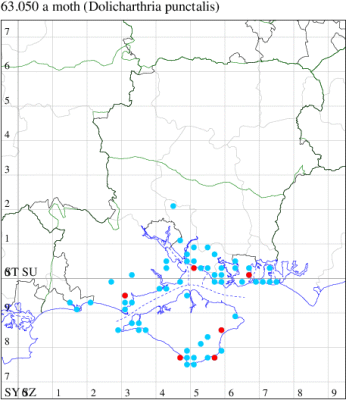
Records by year
Records by week (adult)
Records by week (larval)
Record Details
VC10: Chale, one, field observation, 12 Jul (PBar); Bonchurch, one, 10 Jun; one, 11 Jun; one, 15 Jun; one, 21 Jun; two, 27 Jun; one, 28 Jun; one, 30 Jun; three, 02 Jul; four, 03 Jul; four, 07 Jul; three, 14 Jul (JHa); Sandown, one, 27 Jul (JMar det. JRB);
VC11: Brownwich cliffs, one, 16 Jul (MLO, RJD, KJW); Portsmouth, one, 01 Jul; one, 03 Jul; one, 13 Jul; one, 14 Jul; one, 15 Jul; one, 17 Jul; one, 19 Jul; one, 20 Jul; one, 21 Jul (IRT); Pennington, one, 21 Jul (RFC)
63.052 [B&F: 1398] Rush Veneer Nomophila noctuella ([Denis & Schiffermüller], 1775) - Migrant
Common immigrant from mainland Europe, appearing throughout the British Isles, abundantly in some years, but most frequently and numerously in the south. In Hampshire and on the Isle of Wight a common immigrant, which is widely distributed throughout in some years. Wingspan 25-34 mm. Until recently, this was regarded as an absolutely unmistakable species, but it is now known to comprise a species complex of considerable size, one of which, N. nearctica, has been recorded in Britain. Larva feeds on Leguminosae, over-wintering as a pupa.
Records prior to 2021
| Vice County | #Records | #Individuals | First Record | Last Record |
|---|---|---|---|---|
| 10 | 899 | 15340 | 1947 | 2020 |
| 11 | 8251 | 34734 | 1951 | 2020 |
| 12 | 1632 | 5295 | 1951 | 2020 |
2021 records
| Vice County | #Records | #Individuals | Max Quantity |
|---|---|---|---|
| 10 | 38 | 48 | 6 |
| 11 | 108 | 125 | 3 |
| 12 | 19 | 22 | 2 |
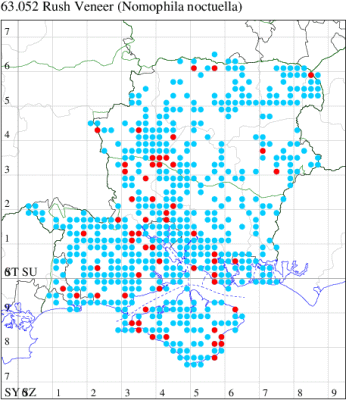
Records by year
Records by week (adult)
Records by week (larval)
Record Summary
VC10: Earliest: Totland, 29 May, 1 (RTer) Latest: Freshwater, 16 Nov, 1 (DCoo) Max count: Freshwater Bay, 26 Aug, 6 (SDav)
VC11: Earliest: Burley, NF, 16 May, 1 (NDP) Latest: Fareham, 28 Oct, 1 (MLO) Max count: Marchwood, 17 Aug, 3 (CTha)
VC12: Earliest: Little Somborne, 28 May, 1 (GCE) Latest: Axmansford, 26 Oct, 1 (ACB) Max count: Cholderton, 10 Sep, 2 (TJN)
63.054 [B&F: 1409a] Box-tree Moth Cydalima perspectalis (Walker, 1859) - Adventive
A native to Asia, and after an initial finding in Germany in 2007, it has been found elsewhere in Europe, thought that the species was originally introduced with imports from China. Since the first finding, larvae have been found in more locations across Germany, sometimes causing severe defoliation as they feed on box (Buxus sp.). By 2008, C. perspectalis had been reported from five countries in Western Europe. In England, it was first recorded in 2008, when adult moths were caught in light traps at Icklesham, East Sussex, and Weybridge, Surrey. In 2009 a nursery in Surrey found perspectalis larvae causing severe damage.
In 2013, a large infestation was discovered at Longstock Nursery in central Hampshire, from which a number of adults were bred. In the same year, a few individuals were caught in the wild, provenance unknown, and it was new for Hampshire and the Isle of Wight in the same year.
As can be seen from the annual distribution graph, a resident population became established around 2016-2017, and numbers are increasing significantly each year. In southern Hampshire in particular it can be one of the most abundant species to light for some unfortunate recorders.
Wingspan 38-42 mm. Somewhat variable, but typical form unmistakable, and there is an attractive purple-black melanic form which is not uncommon. Larva feeds on Box, and may become a horticultural pest in the UK.
Records prior to 2021
| Vice County | #Records | #Individuals | First Record | Last Record |
|---|---|---|---|---|
| 10 | 123 | 346 | 2013 | 2020 |
| 11 | 1065 | 6801 | 2013 | 2020 |
| 12 | 160 | 395 | 2013 | 2020 |
2021 records
| Vice County | #Records | #Individuals | Max Quantity |
|---|---|---|---|
| 10 | 126 | 656 | 51 |
| 11 | 773 | 5709 | 141 |
| 12 | 182 | 629 | 29 |
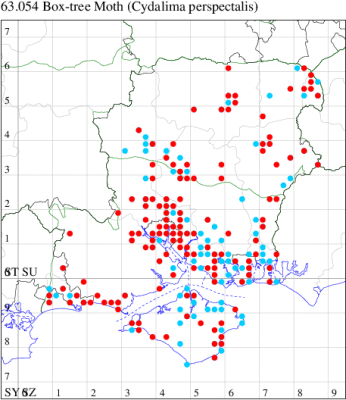
Records by year
Records by week (adult)
Records by week (larval)
Record Summary
VC10: Earliest: Bonchurch, 30 Jun, 2 (JHa) Latest: Freshwater, 09 Nov, 1 (DCoo) Max count: Freshwater, 13 Oct, 51 (DCoo)
VC11: Earliest: Stanbrige Earls, 14 Jun, 1 (JRM) Latest: Highfield, southampton, 11 Nov, 0 (iNat) Max count: Portsmouth, 26 Sep, 141 (IRT)
VC12: Earliest: Blackwater, 29 Jun, 1 (BDal) Latest: Basingstoke, 29 Oct, 1 (DKel) Max count: Blackwater, 14 Sep, 29 (BDal)
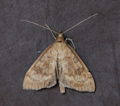
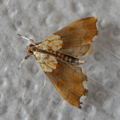
(Larval feeding damage on Buxus(20210826_084427).jpg)
